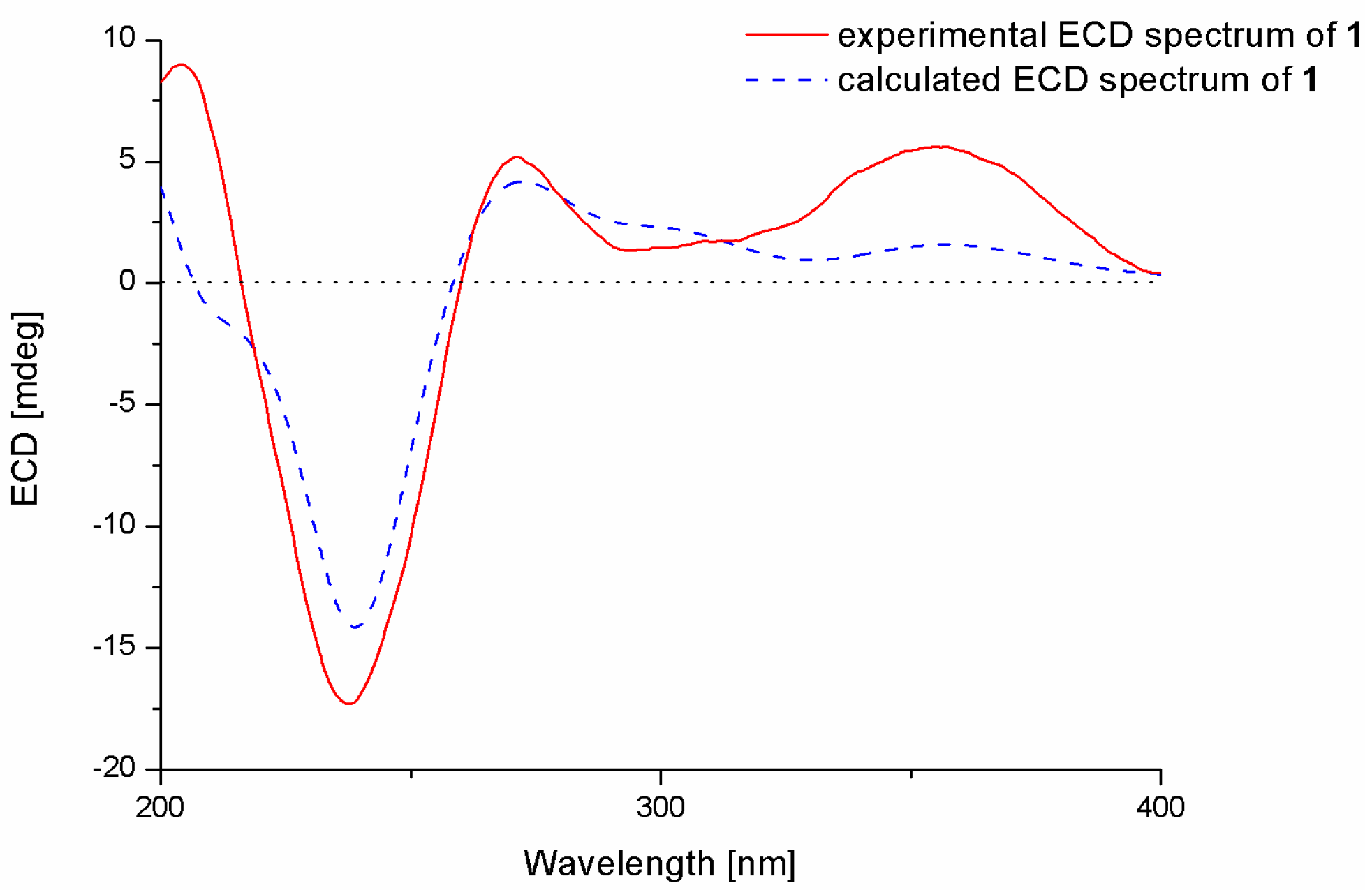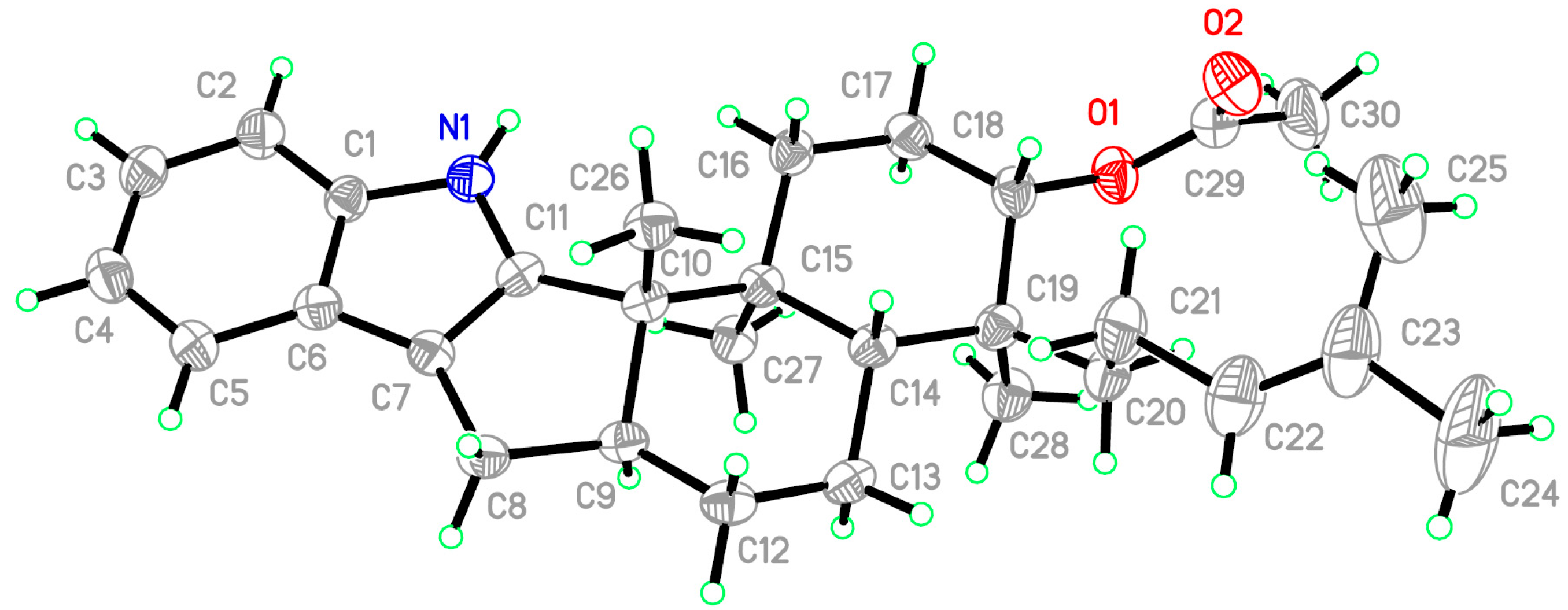Three New Indole Diterpenoids from the Sea-Anemone-Derived Fungus Penicillium sp. AS-79
Abstract
:1. Introduction
2. Results and Discussion
2.1. Structure Elucidation of the New Compounds
2.2. Biological Activities of the Isolated Compounds
3. Experimental Section
3.1. General
3.2. Fungal Material
3.3. Fermentation
3.4. Extraction and Isolation
3.5. X-ray Crystallographic Analysis of Compound 3
3.6. Antimicrobial Assay
4. Conclusions
Supplementary Materials
Acknowledgments
Author Contributions
Conflicts of Interest
References
- Sun, K.L.; Li, Y.; Guo, L.; Wang, Y.; Liu, P.P.; Zhu, W.M. Indolediterpenoids and isocoumarin from the fungus, Aspergillus flavus, isolated from the prawn, Penaeus vannamei. Mar. Drugs 2014, 12, 3970–3981. [Google Scholar] [CrossRef] [PubMed]
- Saikia, S.; Nicholson, M.J.; Young, C.; Parker, E.J.; Scott, B. The genetic basis for indole-diterpene chemical diversity in filamentous fungi. Mycol. Res. 2008, 112, 184–199. [Google Scholar] [CrossRef] [PubMed]
- Byrne, K.M.; Smith, S.K.; Ondeyka, J.G. Biosynthesis of nodulisporic acid A: Precursor studies. J. Am. Chem. Soc. 2002, 124, 7055–7060. [Google Scholar] [CrossRef] [PubMed]
- Qiao, M.F.; Ji, N.Y.; Liu, X.H.; Li, K.; Zhu, Q.M.; Xue, Q.Z. Indoloditerpenes from an algicolous isolate of Aspergillus oryzae. Bioorg. Med. Chem. Lett. 2010, 20, 5677–5680. [Google Scholar] [CrossRef] [PubMed]
- Ding, L.; Maier, A.; Fiebig, H.H.; Lin, W.H.; Hertweck, C. A family of multicyclic indolosesquiterpenes from a bacterial endophyte. Org. Biomol. Chem. 2011, 9, 4029–4031. [Google Scholar] [CrossRef] [PubMed]
- Hensens, O.D.; Ondeyka, J.G.; Dombrowski, A.W.; Ostlind, D.A.; Zink, D.L. Isolation and structure of nodulisporic acid A1 and A2, novel insecticides from a Nodulisporium sp. Tetrahedron Lett. 1999, 40, 5455–5458. [Google Scholar] [CrossRef]
- Knaus, H.G.; McManus, O.B.; Lee, S.H.; Schmalhofer, W.A.; Garcia-Calvo, M.; Helms, L.M.H.; Sanchez, M.; Giangiacomo, K.; Reuben, J.P.; Smith, A.B., III; et al. Tremorgenicindole alkaloids potently inhibit smooth muscle high-conductance calcium-activated potassium channels. Biochemistry 1994, 33, 5819–5828. [Google Scholar] [CrossRef] [PubMed]
- Li, C.; Gloer, J.B.; Wicklow, D.T.; Dowd, P.F. Thiersinines A and B: Novel antiinsectan indole diterpenoids from a new fungicolous Penicillium species (NRRL 28147). Org. Lett. 2002, 4, 3095–3098. [Google Scholar] [CrossRef] [PubMed]
- Ondeyka, J.G.; Helms, G.L.; Hensens, O.D.; Goetz, M.A.; Zink, D.L.; Tsipouras, A.; Shoop, W.L.; Slayton, L.; Dombrowski, A.W.; Polishook, J.D.; et al. Nodulisporic acid A, a novel and potent insecticide from a Nodulisporium sp. isolation, structure determination, and chemical transformations. J. Am. Chem. Soc. 1997, 119, 8809–8816. [Google Scholar] [CrossRef]
- Du, F.Y.; Zhang, P.; Li, X.M.; Li, C.C.; Cui, C.M.; Wang, B.G. Cyclohexadepsipeptides of the isaridin class from the marine-derived fungus Beauveriafelina EN-135. J. Nat. Prod. 2014, 77, 1164–1169. [Google Scholar] [CrossRef] [PubMed]
- Meng, L.H.; Wang, C.Y.; Mándi, A.; Li, X.M.; Hu, X.Y.; Kassack, U.M.; Kurtán, T.; Wang, B.G. Three diketopiperazine alkaloids with spirocyclic skeletons and one bisthiodiketopiperazine derivative from the mangrove-derived endophytic fungus Penicillium brocae MA-231. Org. Lett. 2016, 18, 5304–5307. [Google Scholar] [CrossRef] [PubMed]
- Li, H.L.; Li, X.M.; Liu, H.; Meng, L.H.; Wang, B.G. Two new diphenylketones and a new xanthone from Talaromyces islandicus EN-501, an endophytic fungus derived from the marine red alga Laurencia okamurai. Mar. Drugs 2016, 14, 223. [Google Scholar] [CrossRef] [PubMed]
- Xu, M.J.; Gessner, G.; Groth, I.; Lange, C.; Christner, A.; Bruhn, T.; Deng, Z.W.; Li, X.; Heinemann, S.H.; Grabley, S.; et al. Shearinines D-K, new indoletriterpenoids from an endophytic Penicillium sp. (strain HKI0459) with blocking activity on large-conductance calcium-activated potassium channels. Tetrahedron 2007, 63, 435–444. [Google Scholar] [CrossRef]
- Sun, H.; Gao, S.S.; Li, X.M.; Li, C.S.; Wang, B.G. Chemical constituents of marine mangrove-derived endophytic fungus Alternaria tenuissima EN-192. Chin. J. Oceanol. Limnol. 2013, 31, 464–470. [Google Scholar] [CrossRef]
- Harms, H.; Rempel, V.; Kehraus, S.; Kaiser, M.; Hufendiek, P.; Müller, C.E.; König, G.M. Indoloditerpenes from a marine-derived fungal strain of Dichotomomyces cejpii with antagonistic activity at GPR18 and cannabinoid receptor. J. Nat. Prod. 2014, 77, 673–677. [Google Scholar] [CrossRef] [PubMed]
- Dorner, W.J.; Cole, J.R.; Cox, H.R.; Cunfer, M.B. Paspalitrem C, a new metabolite from sclerotia of Claviceps paspali. J. Agric. Food Chem. 1984, 32, 1069–1071. [Google Scholar] [CrossRef]
- Springer, P.J.; Clardy, J.; Wells, M.J.; Cole, J.R.; Kirksey, W. The structure of paxilline, a tremorgenic metabolite of Penicillium paxilli bainier. Tetrahedron Lett. 1975, 16, 2531–2534. [Google Scholar] [CrossRef]
- Fan, Y.Q.; Wang, Y.; Liu, P.P.; Fu, P.; Zhu, T.H.; Wang, W.; Zhu, W.M. Indole-diterpenoids with anti-H1N1 activity from the aciduric fungus Penicillium camemberti OUCMDZ-1492. J. Nat. Prod. 2013, 76, 1328–1337. [Google Scholar] [CrossRef] [PubMed]
- Hosoe, T.; Nozawa, K.; Udagawa, S.I.; Nakajima, S.; Kawai, K.I. Structures of new indoloditerpenes, possible biosynthetic precursors of the tremorgenic mycotoxins, penitrems, from Penicillium crustosum. Chem. Pharm. Bull. 1990, 38, 3473–3475. [Google Scholar] [CrossRef]
- Tepaske, R.M.; Gloer, B.J.; Wicklow, T.D.; Dowd, F.P. Three new aflavinines from sclerotia of Aspergillus tubingensis. Tetrahedron 1989, 45, 4961–4968. [Google Scholar] [CrossRef]
- Wang, S.; Li, X.M.; Teuscher, F.; Li, D.L.; Diesel, A.; Ebel, R.; Proksch, P.; Wang, B.G. Chaetopyranin, a benzaldehyde derivative, and other related metabolites from Chaetomium globosum, an endophytic fungus derived from the marine red alga Polysiphonia urceolata. J. Nat. Prod. 2006, 69, 1622–1625. [Google Scholar] [CrossRef] [PubMed]
- Visagie, C.M.; Houbraken, J.; Frisvad, J.C.; Hong, S.-B.; Klaassen, C.H.W.; Perrone, G.; Seifert, K.A.; Varga, J.; Yaguchi, T.; Samson, R.A. Identification and nomenclature of the genus Penicillium. Stud. Mycol. 2014, 78, 343–371. [Google Scholar] [CrossRef] [PubMed]
- Crystallographic Data of Compound 3 Have Been Deposited in the Cambridge Crystallographic Data Centre (CCDC 1529887). Available online: http://www.ccdc.cam.ac.uk/data_request/cif (accessed on 11 May 2017).
- Sheldrick, G.M. SADABS, Software for Empirical Absorption Correction; University of Göttingen: Göttingen, Germany, 1996. [Google Scholar]
- Sheldrick, G.M. SHELXTL, Structure Determination Software Programs; Bruker Analytical X-ray System Inc.: Madison, WI, USA, 1997. [Google Scholar]
- Sheldrick, G.M. SHELXL-97 and SHELXS-97, Program for X-ray Crystal Structure Solution and Refinement; University of Göttingen: Göttingen, Germany, 1997. [Google Scholar]
- Al-Burtamani, S.K.S.; Fatope, M.O.; Marwah, R.G.; Onifade, A.K.; Al-Saidi, S.H. Chemical composition, antibacterial and antifungal activities of the essential oil of Haplophyllum tuberculatum from Oman. J. Ethnopharmacol. 2005, 96, 107–112. [Google Scholar] [CrossRef] [PubMed]






| No. | 1 a | 2 a | 3 b | |||
|---|---|---|---|---|---|---|
| 1H | 13C | 1H | 13C | 1H | 13C | |
| 1 | 7.75, s | 7.73, s | 9.79, s | |||
| 2 | 151.8, C | 149.9, C | 151.8, C | |||
| 3 | 51.8, C | 51.2, C | 53.9, C | |||
| 4 | 40.1, C | 38.1, C | 38.6, C | |||
| 5 | α 2.79, m | 27.2, CH2 | α 2.59, d (14.8) | 37.5, CH2 | α 1.80, m | 24.7, CH2 |
| β 1.72, m | β 2.17, d (5.2) | β 1.73, m | ||||
| 6 | α 2.82, m | 28.4, CH2 | 4.15, d (5.0) | 70.4, CH | α 1.89, m | 23.3, CH2 |
| β 2.05, m | β 1.69, m | |||||
| 7 | 104.5, C | 103.3, C | 4.88, dd (10.7, 4.3) | 75.9, CH | ||
| 8 | 40.0, C | |||||
| 9 | 4.33, s | 88.2, CH | 4.37, s | 88.4, CH | 1.51, br.s | 41.0, CH |
| 10 | 197.2, C | 195.2, C | α 1.79, m | 28.0, CH2 | ||
| β1.72, m | ||||||
| 11 | 5.86, s | 117.8, CH | 5.87, s | 118.7, CH | α 1.80, m | 33.1, CH2 |
| β 1.68, m | ||||||
| 12 | 169.8, C | 171.3, C | 2.80, m | 49.8, CH | ||
| 13 | 77.8, C | 3.68, dt (3.4, 11.7) | 39.5, CH | α 2.36, dd (13.1, 10.9) | 28.0, CH2 | |
| β 2.68, dd (13.1, 6.4) | ||||||
| 14 | α 2.05, m | 34.5, CH2 | α 1.97, m | 24.1, CH2 | 117.9, C | |
| β 1.92, m | β 1.48, m | |||||
| 15 | α 2.05, m | 21.3, CH2 | α 1.85, m | 24.0, CH2 | 131.5, C | |
| β 1.72, m | β 1.77, m | |||||
| 16 | 2.64, m | 48.6, CH | 2.83, m | 48.4, CH | 7.36, d (7.4) | 118.8, CH |
| 17 | α 2.79, dd (12.4, 5.6) | 27.8, CH2 | α 2.74, dd (13.2, 6.3) | 27.8, CH2 | 6.99, dt (7.1, 1.6) | 119.7, CH |
| β 2.05, dd (12.4, 3.1) | β 2.41, dd (13.2, 10.6) | |||||
| 18 | 117.8, C | 118.5. C | 6.99, dt (7.1, 1.6) | 120.6, CH | ||
| 19 | 123.6, C | 125.3, C | 7.32, d (7.3) | 112.6, C | ||
| 20 | 7.56, s | 114.1, CH | 7.46, d (7.9) | 119.9, CH | 7.32, d (7.3) | 141.7, C |
| 21 | 136.8, C | 7.11, t (6.2) | 120.8, CH | 1.10, s | 15.0, CH3 | |
| 22 | 5.19, s | 76.3, CH | 7.11, t (6.2) | 121.5, CH | 1.18, s | 19.4, CH3 |
| 23 | 144.8, C | 7.34, d (8.2) | 111.7, CH | 0.95, s | 18.1, CH3 | |
| 24 | 73.8, C | 140.3, C | α 1.52, m | 29.9, CH2 | ||
| β 1.23, m | ||||||
| 25 | 1.16, s | 15.5, CH3 | α 2.08, m | 22.1, CH2 | ||
| β 1.80, m | ||||||
| 26 | 71.3, C | 1.18, s | 21.6, CH3 | 5.11, t (7.1) | 125.5, CH | |
| 27 | α 2.45, d (18.0) | 34.1, CH2 | 79.8, C | 126.1, C | ||
| β 2.43, d (18.0) | ||||||
| 28 | 138.4, C | 1.44, s | 28.7, CH3 | 1.63, s | 25.9, CH3 | |
| 29 | 133.9, C | 1.24, s | 23.2, CH3 | 1.69, s | 17.6, CH3 | |
| 30 | 7.02, s | 102.1, CH | 170.6, C | |||
| 31 | 140.0, C | 2.05, s | 21.1, CH3 | |||
| 32 | 1.37, s | 16.3, CH3 | ||||
| 33 | 1.25, s | 23.8, CH3 | ||||
| 34 | 78.9, C | |||||
| 35 | 1.20, s | 23.2, CH3 | ||||
| 36 | 1.46, s | 29.0, CH3 | ||||
| 37 | 1.55, s | 30.4, CH3 | ||||
| 38 | 1.50, s | 30.0, CH3 | ||||
| 39 | 1.29, s | 29.7, CH3 | ||||
| 40 | 1.37, s | 29.5, CH3 | ||||
© 2017 by the authors. Licensee MDPI, Basel, Switzerland. This article is an open access article distributed under the terms and conditions of the Creative Commons Attribution (CC BY) license (http://creativecommons.org/licenses/by/4.0/).
Share and Cite
Hu, X.-Y.; Meng, L.-H.; Li, X.; Yang, S.-Q.; Li, X.-M.; Wang, B.-G. Three New Indole Diterpenoids from the Sea-Anemone-Derived Fungus Penicillium sp. AS-79. Mar. Drugs 2017, 15, 137. https://doi.org/10.3390/md15050137
Hu X-Y, Meng L-H, Li X, Yang S-Q, Li X-M, Wang B-G. Three New Indole Diterpenoids from the Sea-Anemone-Derived Fungus Penicillium sp. AS-79. Marine Drugs. 2017; 15(5):137. https://doi.org/10.3390/md15050137
Chicago/Turabian StyleHu, Xue-Yi, Ling-Hong Meng, Xin Li, Sui-Qun Yang, Xiao-Ming Li, and Bin-Gui Wang. 2017. "Three New Indole Diterpenoids from the Sea-Anemone-Derived Fungus Penicillium sp. AS-79" Marine Drugs 15, no. 5: 137. https://doi.org/10.3390/md15050137






